|
NASA Gemini
Missions
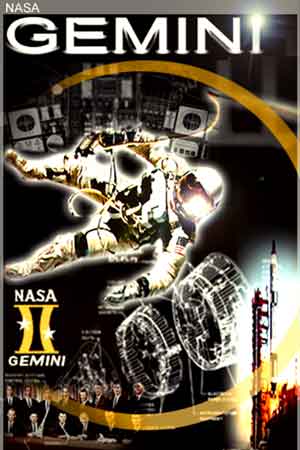
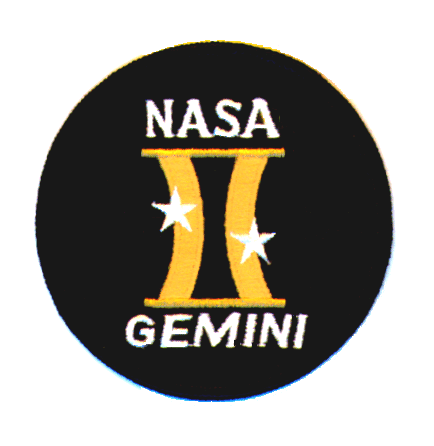
The National Aeronautics and
Space Administration announced December 7, 1961, a plan to extend the existing
manned space flight program by development of a two-man spacecraft. The program
was officially designated Gemini on January 3, 1962. It was named after the
third constellation of the zodiac, featuring the twin stars Castor and Pollux.
The program was operationally completed with the Gemini XII flight. The Gemini
program was managed by the Manned Spacecraft Center, Houston, Texas, under
direction of the Office of Manned Space Flight, NASA Headquarters, Washington,
D.C, Dr. George E. Mueller, Associate Administrator of NASA for Manned Space
Flight, served as acting director of the Gemini program. William C. Schneider,
Deputy Director of Manned Space Flight for Mission Operations, served as Mission
Director on all Gemini flights beginning with Gemini V. The Manned Spacecraft
Center Gemini effort was headed by Dr. Robert R. Gilruth, director of the
Center, and Charles W. Matthews, Gemini Program Manager.
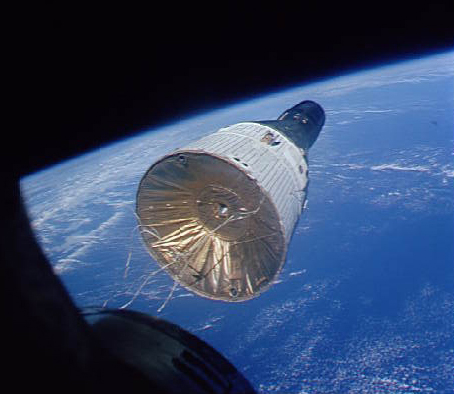
PROGRAM
OBJECTIVES
The Gemini Program was conceived
after it became evident to NASA officials that an intermediate step was required
between Project Mercury and the Apollo Program. The major objectives assigned to
Gemini were: To subject two men and supporting equipment to long duration
flights -- a requirement for projected later trips to the moon or deeper space.
To effect rendezvous and docking with other orbiting vehicles, and to maneuver
the docked vehicles in space, using the propulsion system of the target vehicle
for such maneuvers. To perfect methods of reentry and landing the spacecraft at
a pre-selected land-landing point. To gain additional information concerning the
effects of weightlessness on crew members and to record the physiological
reactions of crew members during long duration flights. A brief summary of the
Gemini flight results reveals how successful the Gemini Program was. All of the
major objectives were met as well as many other objectives assigned to each
mission, with the exception of land landing which was canceled from the Gemini
Program in 1964. However, the precision control necessary to achieve the land
landing objective was demonstrated.
Gemini Goals
The second U.S. manned space program was announced in January 1962.
Its two-man crew gave it its name, Gemini, for the third constellation of the
Zodiac and its twin stars, Castor and Pollux. Gemini involved 12 flights,
including two unmanned flight tests of the equipment. Like Mercury's, its major
objectives were clear-cut:
- To subject man and equipment
to space flight up to two weeks in duration.
- To rendezvous and dock with
orbiting vehicles and to maneuver the docked combination by using the target
vehicle's propulsion system;
- To perfect methods of entering
the atmosphere and landing at a preselected point on land. Its goals were also
met, with the exception of a land landing, which was cancelled in 1964.
THE SPACECRAFT
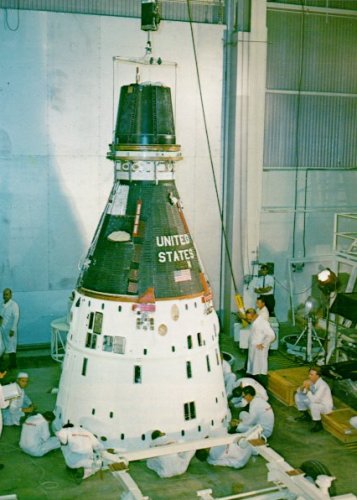
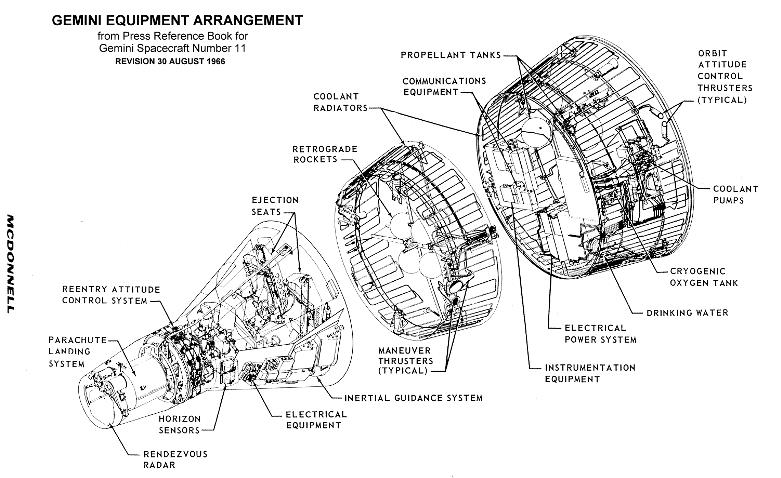
The spacecraft was an enlargement
of the familiar Mercury capsule--5.8m (19 ft) long, 3m (10 ft) in diameter, and
about 3810 kilograms (8400 pounds) in weight. Engineering changes simplified
maintenance and made it more maneuverable for the pilots. The Titan II rocket,
more powerful than the Redstone, placed the larger spacecraft into orbit.
Sometimes referred to as Gemini-Titan for the craft and its launch vehicle, each
flight was designated by a Roman numeral. Only the first capsule was nicknamed;
Command Pilot Virgil Grissom called it the MOLLY BROWN in reference to his
Mercury spacecraft that sank.
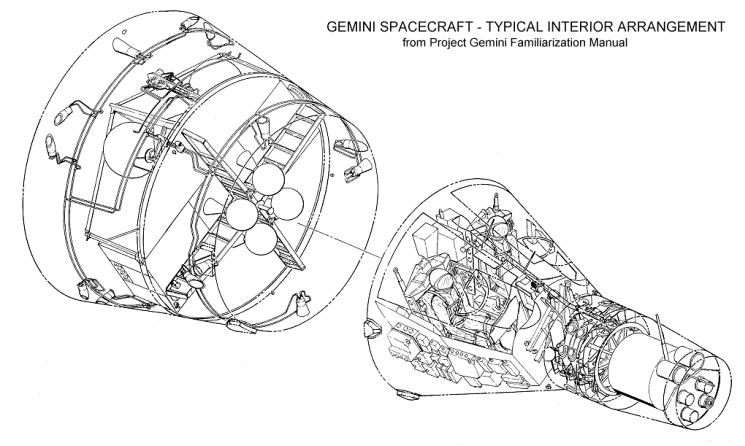
THE MANNED FLIGHTS
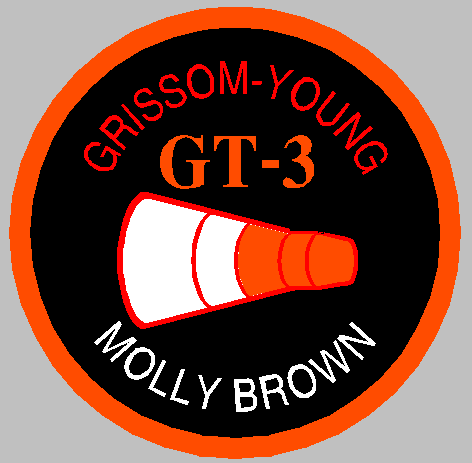
Gemini-3
- Pad LC-19 ()
- Titan-II (3)
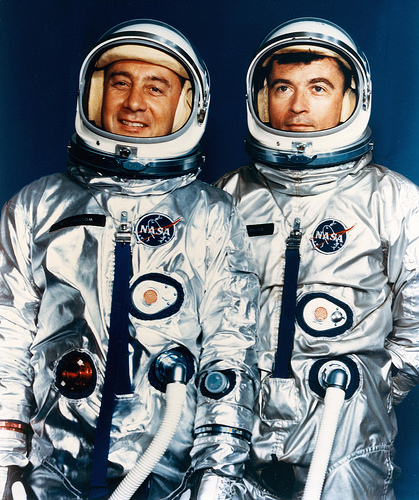
Crew:
- Virgil I. Grissom (2),
commander
- John W. Young (1), pilot
Backup Crew:
- Walter M. Schirra, Jr.
- Thomas P. Stafford
CapCom:
- L. Gordon Cooper (Cape)
- Roger B. Chaffee (Houston)
Milestones:
Payload:
- Gemini-3 capsule
Mission Objective:
- Demonstrate manned orbital
flight; evaluate two-man design. Demonstrate and evaluate tracking network.
Demonstrate OAMS capability in orbital maneuvers and in retrofire backup.
Demonstrate controlled reentry and landing. Evaluate major spacecraft
subsystems. Demonstrate systems checkout, prelaunch, and launch procedures.
Demonstrate and evaluate recovery procedures and systems. Spacecraft weight:
3225kg.
- Secondary objectives included:
Evaluate flight crew equipment, biomedical instrumentation, and personal
hygiene system. Perform 3 experiments. Evaluate low-level longitudinal
oscillations (Pogo) of the GLV. General photographic coverage in orbit.
Launch:
- March 23, 1965 9:24:00.064 am
EST. There was one brief hold on launch day while a sensor on an oxidizer line
was adjusted.
Orbit:
- Altitude: 224km
- Inclination: 33.0 degrees
- Orbits: 3
- Duration: 0 Days, 4 hours, 52
min, 31 seconds
- Distance:
Landing:
- March 23, 1965. Landing at
22deg26m North and 70deg 51min West. Miss distance from landing zone 111.1km
(60nm). Recovered by USS Intrepid. Crew onboard in 70 min.
-
Mission Highlights:
- All primary objectives were
achieved except the controlled reentry objective was only partially achieved.
The angle of attack during reentry was lower than expected. Secondary
objectives were only partially achieved. The personal hygiene system was only
partially tested, Operating mechanism failed on S-2 - Synergistic Effect of
Zero Gravity on Sea Urchin Eggs Experiment and the photographic coverage
objective was only partially successful because of an improper lens setting on
the 16mm camera.
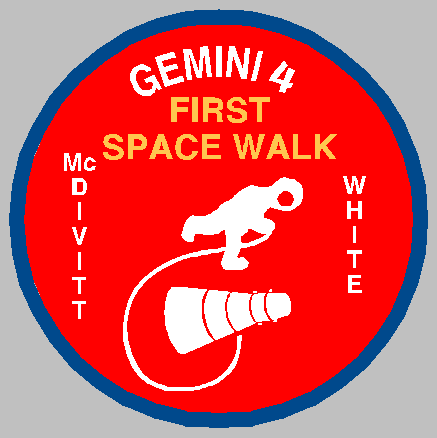
Gemini IV June 03-07, 1965
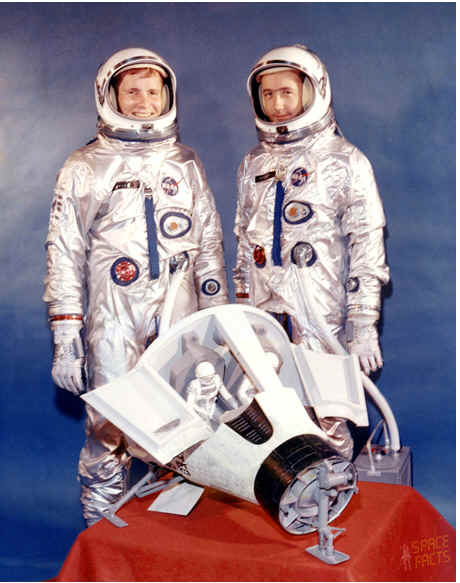
- Pad LC-19 ()
- Titan-II (4)
- 1st NASA EVA
Crew:
- James A. McDivitt (1),
Commander
- Edward H. White II (1), Pilot
Backup Crew:
- Frank Borman
- James A. Lovell, Jr.
CapCom:
- Clifton C. Williams, Jr.
(Cape)
- Virgil I. Grissom (Houston)
Milestones:
Payload:
- Gemini-IV capsule
Mission Objective:
- Evaluate effects of prolonged
space flight. Demonstrate and evaluate performance of spacecraft and systems
in 4-day flight. Evaluate procedures for crew rest and work cycles, eating
schedules, and realtime flight planning. Spacecraft weight: 3574kg.
- Secondary objectives included:
Demonstrate and evaluate EVA and control by use of HHMU and tether.
Stationkeep and rendezvous with second stage of GLV. Evaluate spacecraft
systems. Make in-and-out-of plane maneuvers. Further test OAMS retro backup
capability. Perform 11 experiments.
Launch:
- June 3, 1965 10:15:59.562 am.
Orbit:
- Altitude: 296.1 km (159.9nm)
- Inclination: 32.5 degrees
- Orbits: 62
- Duration: 4 Days, 1 hour, 56
min, 12 seconds
- Distance: km
Landing:
- June 7, 1965. Landing was at
27deg 44min North and 74deg 11min West. Landing was 81.4km from attempted
landing zone.
-
Mission Highlights:
- Gemini-4 was NASA's 1st Extra
Vehicular Activity (EVA) operation. EVA time 36min
- All but one primary objectives
were achieved. Computer controlled reentry in the demonstration and evaluation
of spacecraft systems objective was not flown because of inadvertent
alteration of computer memory. All secondary objectives were met except one.
The secondary objective of stationkeeping and rendezvous was only partially
successful because separation and rendezvous was not attempted due to fuel
consumption.
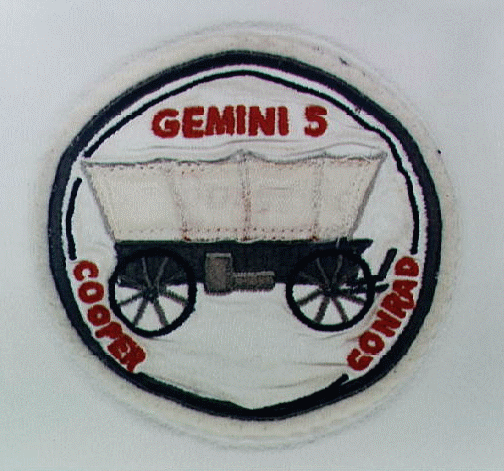
Gemini V August 21-29, 1965
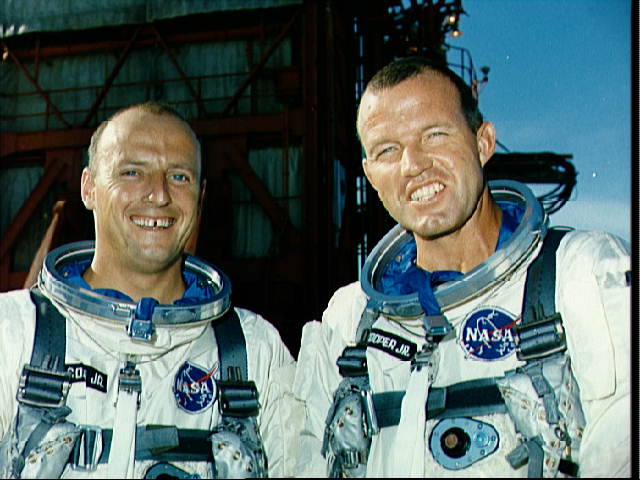
Pad LC-19 ()
Titan-II (5)
Crew:
C. Gordon Cooper (2), Commander
Charles Conrad, Jr (1), Pilot
Backup Crew:
Neil A. Armstrong
Elliot M. See, Jr
CapCom:
Virgil I. Grissom (Cape)
James A. McDivitt (Houston)
Edwin E. Aldrin (Houston)
Neil A. Armstrong (Houston)
Milestones:
Payload:
Gemini-V capsule
Mission Objective:
Evaluate rendezvous Guidance and Navigation system with REP. Demonstrate 8-day
capability of spacecraft and crew. Evaluate effects on weightlessness for 8-day
flight. Spacecraft weight: 3605kg.
Secondary objectives included:
Demonstrate controlled reentry guidance. Evaluate fuel cell. Demonstrate all
phases of guidance and control system operation needed for rendezvous. Evaluate
capability of both crewmen to maneuver spacecraft to rendezvous. Checkout
rendezvous radar. Execute 17 experiments.
Launch:
August 21, 1965; 8:59:59.518am EST. A launch attempt on August 19 was postponed
due to weather conditions and problems with loading cryogenic fuel for the fuel
cell.
Orbit:
Altitude: 349.8 km
Inclination: 32.61 degrees
Orbits: 120
Duration: 7 Days, 22 hours, 55 min, 14 seconds
Distance: km
Landing:
August 29, 1965. Landing was at 29deg44min North and 69deg 45min West. Miss
distance was 170.3km (92nm). Navy divers from the backup recovery ship USS
DuPont (DD-941) recovered the crew and transfered them via helicopter to the USS
Lake Champlain (crew onboard in 89 min).
Mission Highlights:
During the mission, problems developed with the fuel cell that precluded
rendezvous with the radar evaluation pod (REP). Primary rendezvous G&N system
with REP objective was not achieved. REP rendezvous was not attempted due to a
decision to power down fuel cells.
Secondary objective to
demonstrate controlled reentry guidance was not achieved due to incorrect
navigation coordinates transmitted to the spacecraft computer from the ground.
This caused an 89mile overshoot of the landing zone. Experiment D-2, Nearby
Object Photography was not conducted when REP rendezvous was canceled.
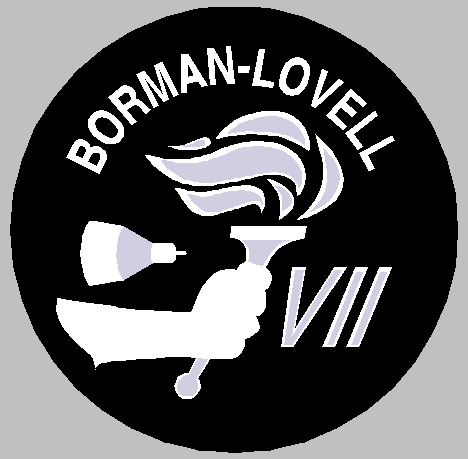
Gemini VII
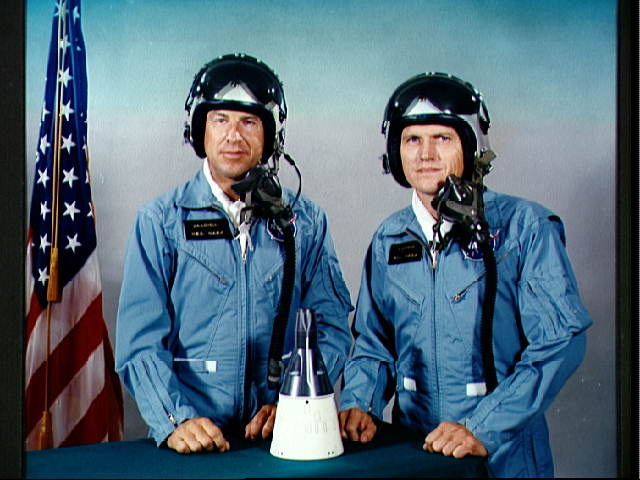
Pad LC-19 ()
Titan-II (6)
Crew:
Frank Borman (1), Commander
James A. Lovell (1), Pilot
Backup Crew:
Edward H. White II
Michael Collins
CapCom:
Alan L. Bean (Cape)
Elliot M. See Jr. (Houston)
Eugene A. Cernan (Houston)
Charles A. Bassett II (Houston)
Milestones:
Payload:
Gemini-VII capsule
Mission Objective:
Primary object was to conduct 14-day mission and evaluate effects on crew.
Secondary objectives included: Provide target for Gemini VI-A. Stationkeep with
Gemini VI-A and with second stage of GLV. Conduct 20 experiments. Evaluate
lightweight pressure suit. Evaluate spacecraft reentry capability. Conduct
systems tests. Spacecraft weight: 3663kg.
Launch:
December 4, 1965 2:30:03.702pm EST
Orbit:
Altitude: 327km (177.1 nm)
Inclination: 28.89 degrees
Orbits: 206
Duration: 13 Days, 18 hours, 35 min, 1 seconds
Distance: km
Landing:
December 18, 1965. Landed at 25deg 25.1min North, 70.6deg 7min West Miss
distance was 11.8km (6.4nm).
Mission Highlights:
All primary and secondary objectives were achieved.
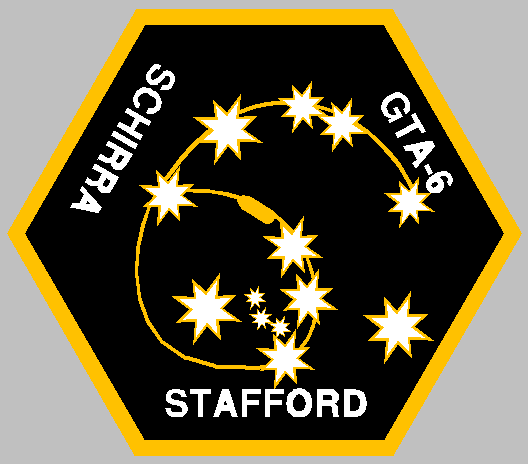
Gemini VI December 15-16, 1965
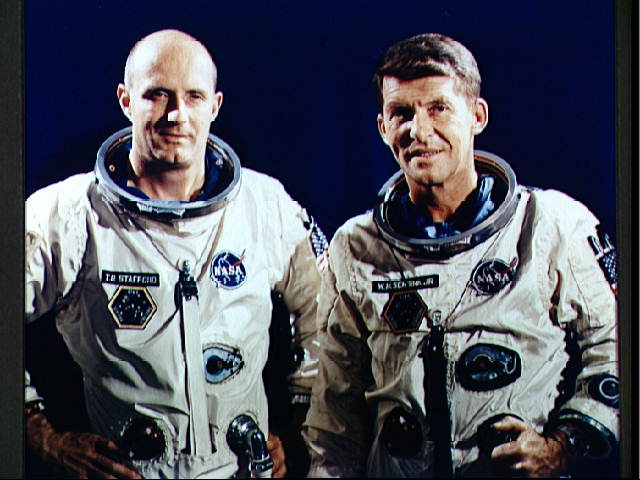
Pad LC-19 ()
Titan-II (7)
Crew:
Walter M. Schirra Jr. (1), Commander
Thomas P. Stafford (1), Pilot
Backup Crew:
Virgil I. Grissom
John W. Young
CapCom:
Alan L. Bean (Cape)
Elliot M. See (Houston)
Eugene A. Cernan (Houston)
Charles A. Bassett II (Houston)
Milestones:
Payload:
Gemini-VI-A capsule
Mission Objective:
Primary objective was to rendezvous with Gemini-VII. Secondary objectives
included: Perform closed-loop rendezvous in fourth orbit. Stationkeep with
Gemini VII. Evaluate reentry guidance capability. Conduct visibility tests for
rendezvous, using Gemini VII as target. Perform 3 experiments. Spacecraft weight
3546kg.
Launch:
Dec 15, 1965 8:37:26.471 am EST. Due to a Gemini Agena target vehicle (GATV)
propulsion failure on 25 Oct, 1965 the mission was rescheduled. The Agena target
vehicle Gemini Agena target vehicle GATV-5002 and TLV 5301 with which the
Gemini-VI-A was to rendezvous and dock, failed to go into orbit. A launch
attempt on Dec 12, 1965 failed because of a minor launch vehicle hardware
problem.
Orbit:
Altitude: 311.3km (168.1 nm)
Inclination: 28.89 degrees
Orbits: 16
Duration: 1 Day, 1 hour, 51 min, 24 seconds
Distance: km
Landing:
December 16, 1965. Landing was at 23deg 35min North and 67deg 50min West. Miss
distance was 12.9km (7nm). Recovered by the USS Wasp (crew onboard in 66min).
Mission Highlights:
All primary objectives were achieved. Secondary objective on experiment D-8
Radiation in Spacecraft because stationkeeping with Gemini-VII interfered with
the experiment.
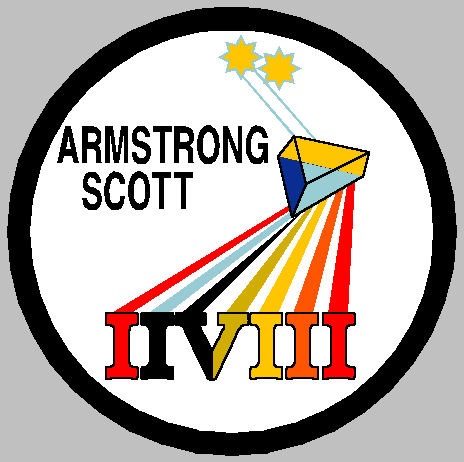
Gemini VIII March 16, 1966
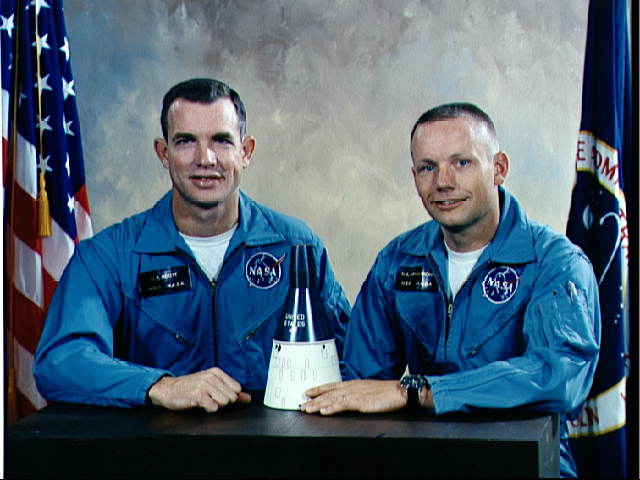
Pad LC-19 ()
Titan-II (8)
Crew:
Neil A. Armstrong
David R. Scott
Backup Crew:
Charles Conrad Jr.
Richard F. Gordon, Jr.
CapCom:
R. Walter Cunningham (Cape)
James A. Lovell Jr. (Houston)
Milestones:
Payload:
Gemini-XIII capsule
Mission Objective:
Primary objective was to rendezvous and dock with Gemini Agena target vehicle
(GATV-5003) launched on 3/16/1966 from Complex 14 (TLV-5302) and conduct EVA
operations. Secondary objectives included: Rendezvous and dock in 4th
revolution. Perform docked-vehicle maneuvers, Evaluate systems and conduct 10
experiments. Spacecraft weight: 3788kg. GATV-5003 Weight: 8097.
Launch:
March 16, 1966. 11:41:02.389. There was a one day delay in launching the
spacecraft due to minor problems with the spacecraft and launch vehicle
hardware.
Orbit:
Altitude: 298.7km (161.3 nm)
Inclination: 28.91 degrees
Orbits: 7
Duration: 0 Days, 10 hours, 41 min, 26 seconds
Distance: km
Landing:
March 17, 1966. Landing was at 25deg 13.8min North and 136deg 0min East. Pacific
Ocean. Recovered by the USS Mason (crew onboard in 3 hours).
Mission Highlights:
Gemini-VIII successfully docked with Gemini Agena target vehicle GATV-6 hours 34
min after liftoff. Because of problems with the spacecraft control system, the
crew was forced to undock after approximately 30 min. The spacecraft-target
vehicle combination had begun to encounter increasing yaw and roll rates. The
crew regained control of their spacecraft by using the reentry control system,
which prompted an early landing in a secondary landing area in the Pacific. No
EVA was performed.
The failure was caused by an electrical short in control system. Docking and
re-rendezvous secondary objectives were not achieved due to the shortened
mission.
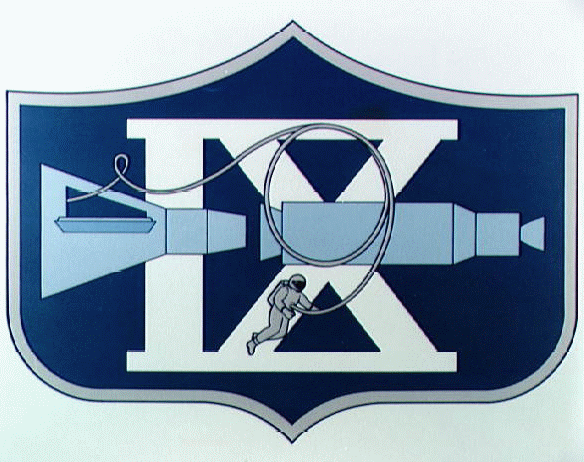
Gemini IX June 03-06, 1966
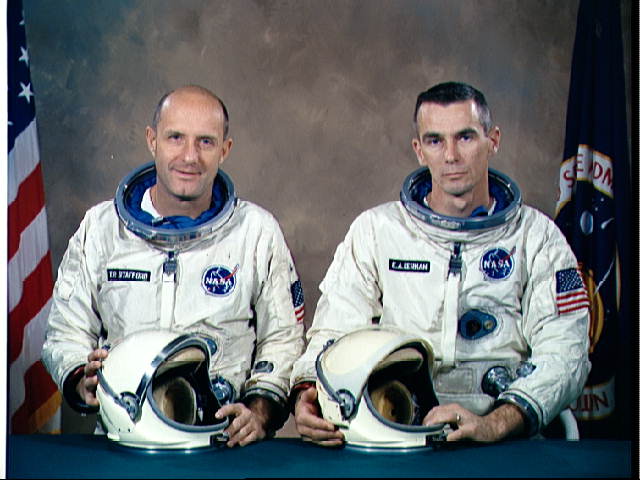
Pad LC-19 ()
Titan-II (9)
EVA
Crew:
Thomas P. Stafford (2), Commander
Eugene A. Cernan (1), Pilot
Backup Crew:
James A. Lovell Jr,
Edwin E. Aldrin
Capcoms:
Edwin E. Aldrin, Jr.
(Cape,Houston)
Neil A. Armstrong (Houston)
James A. Lovell, Jr. (Houston)
Richard F. Gordon, Jr. (Houston)
Milestones:
Payload:
Gemini-IX-A capsule
Mission Objective:
Primary objective was to perform rendezvous and docking and conduct EVA.
Secondary objectives included: Rendezvous with ATDA (launched 6/1/66 from
Complex 14) in 3rd revolution. Conduct systems evaluation and equiperiod
rendezvous. Execute 7 experiments. Practice Docking, Rendezvous from above and
to demonstrate controlled reentry. The original crew of Gemini-IX, Elliott M.
See and Charles Bassett were killed in an airplane crash on February 28, 1966.
The backup crew was named to the prime crew positions. Spacecraft weight:
3750kg. ATDA weight: 1088kg
Launch:
June 3, 1966 8:39:33.335 am EST. GT-9 was postponed when TLV 5303 with Gemini
Agena target vehicle GATV-5004 malfunctioned on May 17. In its place, a
substitute target was used for GT-9A; the Augmented Target Docking Adapter
(ATDA) was launched by an Atlas on June 1, 1966 (TLV-5304) from Launch Complex
14; However GT-9A was not launched the same day as planned due to a guidance
system computer problem. After a brief hold, the spacecraft was launched on the
3rd day.
Orbit:
Altitude: 311.5km (168nm)
Inclination: 28.86 degrees
Orbits: 45
Duration: 3 Days, 0 hours, 20 min, 50 seconds
Distance: km
Landing:
June 6, 1966. Landing was at 27deg 52min N and 75deg 0.4min West. Miss distance
.704 miles (.38 nm). Recovery ship USS Wasp (crew onboard in 52 min).
Mission Highlights:
Primary objective of rendezvous and docking was only partially achieved because
the shroud on the ATDA failed to jettison. Instead GT-9A performed a number of
rendezvous maneuvers, including a simulation of lunar module rendezvous. EVA
time 2hours 7 min. During EVA maneuvers, Cernan's visor became fogged, and he
was unable to test the Air Force maneuvering unit.
Secondary objective experiment
S-10, Agena Micrometerorite Collection experiment was not attempted because EVA
did not take place near Gemini Agena target vehicle (GATV).
Gemini X July 18-21, 1966
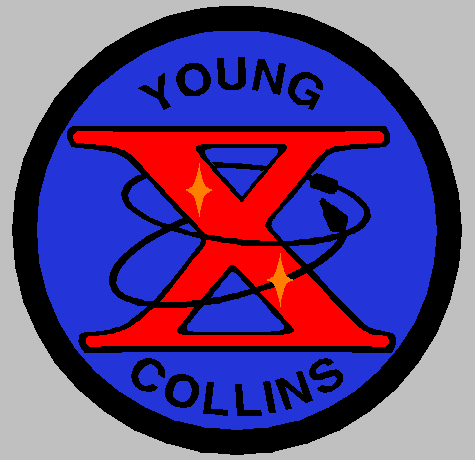
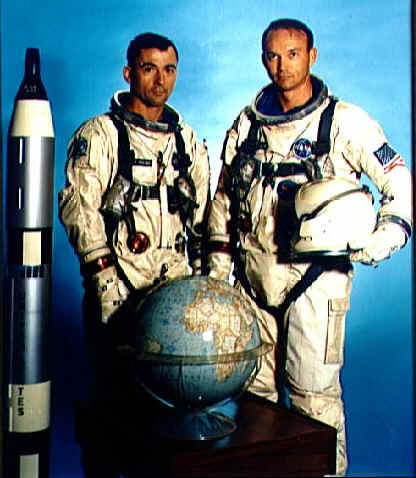
Pad LC-19 ()
Titan-II (10)
EVA
Crew:
John W. Young
Michael Collins
Backup Crew:
Alan L. Bean
Clifton C. Williams, Jr.
CapCom:
L. Gordon Cooper Jr. (Cape, Houston)
Edwin E. Aldrin (Houston)
Milestones:
Payload:
Gemini-X capsule
Mission Objective:
Primary objective was to rendezvous and dock with Gemini Agena target vehicle
(GATV-5005) launched as TLV-5305 from Complex 14 on 7/18/66. Secondary
objectives included: Rendezvous and dock in 4th revolution. Rendezvous with
Gemini Agena target vehicle GATV-8 using Agena propulsion systems, Conduct EVA,
Practice docking, Perform 14 experiments, Perform system evaluation on
bending-mode tests; docked maneuvers; static discharge; monitoring; post-docked
Agena maneuvers; reentry guidance; park Gemini Agena target vehicle (GATV) in
352km (190.3 nm) orbit. Spacecraft weight: 3763kg. GATV weight: 8097kg
Launch:
July 18, 1966. 5:20:26.648 pm EST
Orbit:
Altitude: 753.3km (412.2 nm)
Inclination: 28.85 degrees
Orbits: 43
Duration: 2 days 22 hours 46 min 39 seconds
Distance: km
Landing:
July 21, 1966. 4:07pm. Landing was at 26deg 44.7min North and 71deg 57min West.
Miss distance was 6.2km (3.4 nm).
Mission Highlights:
1 hour, 29 min. EVA. All primary objectives and most secondary objectives were
met. The practice docking secondary objective and some experiments were canceled
due to insufficent fuel reserves.
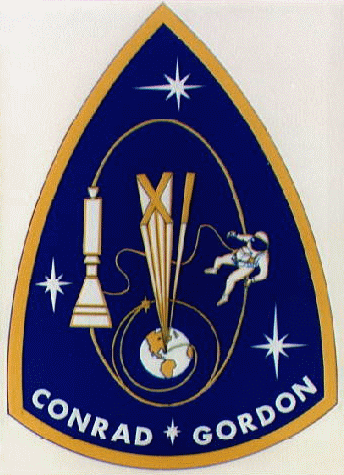
Gemini XI September 12-15, 1966
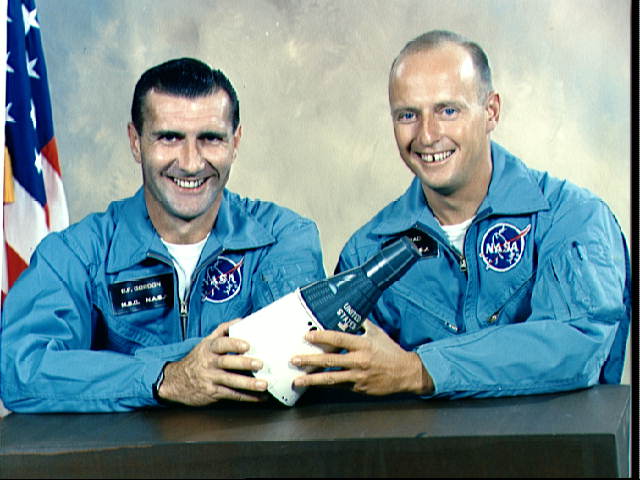
Pad LC-19 ()
Titan-II (11)
Crew:
Charles Conrad Jr.
Richard F. Gordon Jr.
Backup Crew:
Neil A. Armstrong
William A. Anders
CapCom:
Clifton C. Williams Jr. (Cape)
John W. Young (Houston)
Alan L. Bean (Houston)
Milestones:
Payload:
Gemini-XI capsule
Mission Objective:
Primary objective was to rendezvous and dock with Gemini Agena target vehicle
(GATV-5006) which was launched 9/12/66 from Launch Complex 14 as TLV-5306 in 1st
revolution. Secondary objectives included: Practice docking, Perform EVA.
Conduct 11 experiments, Maneuver while docked (high apogee excursion), Conduct
tethered vehicle test, Demonstrate automatic reentry and Park GATV-10 in 352.4km
orbit. Spacecraft weight: 3798kg. GATV weight: 8097kg
Launch:
September 12, 1966 9:42:26.546 am EST. The launch was postponed twice; On
September 9 due to a small leak in the first stage oxidizer tank of the GLV; and
on the 10th due to a suspected malfunction of the autopilot on the GLV. On the
day of the launch there was a 16 min hold due to a suspected leak around the
command pilot's hatch.
Orbit:
Altitude: 1368.9 km (739.2nm)
Inclination: 28.83 degrees
Orbits: 44
Duration: 2 Days 23 hours 17 min 8 seconds
Distance: km
Landing:
September 15, 1966. Landing was at 24deg 15.4min North and 70deg 0.0min West.
Miss distance was 4.9km (2.65nm). Recovery ship USS Guam (crew onboard in 24
min).
Mission Highlights:
All Primary objectives and most secondary objectives were achieved. Experiment
D-16, Power Tool Evaluation was canceled when the EVA was terminated early.
During EVA, astronaut Gordon tethered the two spacecraft together with a
30-meter line. Automatic reentry was successful.
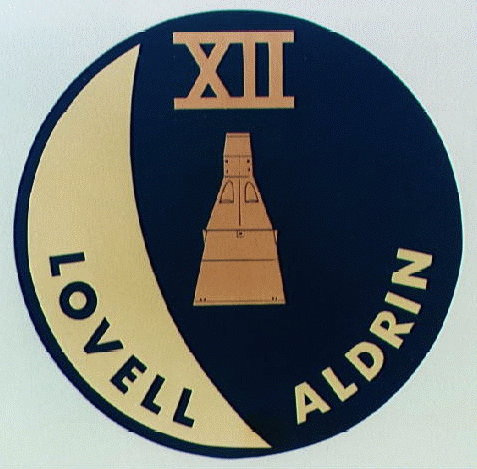
Gemini XII November 11-15,
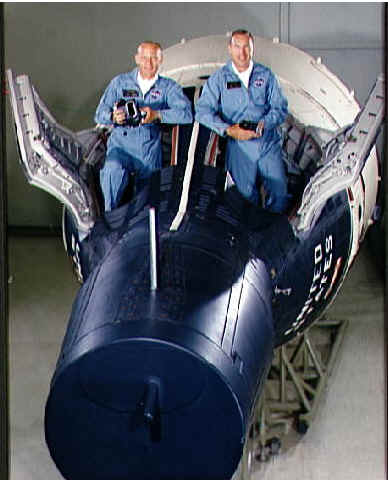
Pad LC-19 ()
Titan-II (12)
Crew:
James A. Lovell Jr., Commander
Edwin E. Aldrin, Pilot
Backup Crew:
L. Gordon Cooper, Jr.
Eugene A. Cernan
CapCom:
Stuart A. Roosa (Cape)
Charles Conrad Jr. (Houston)
William A. Anders (Houston)
Milestones:
Payload:
Gemini-XII capsule
Mission Objective:
Primary object was rendezvous and docking and to evaluate EVA. Secondary
objective included: Tethered vehicle operation, perform 14 experiments,
rendezvous and dock in 3rd revolution, demonstrate automatic reentry, perform
docked maneuvers, practice docking, conduct system tests and to park Gemini
Agena target vehicle GATV-12 in 555.6 km (300nm) orbit.
Launch:
Nov 11, 1966 3:46:33.419 pm EST.
Orbit:
Altitude: 301.3km (162.7nm)
Inclination: 28.78 degrees
Orbits: 59
Duration: 3 Days, 22 hours, 34 min, 31 seconds
Distance: km
Landing:
Nov 15, 1966. Landed at 24deg 35min North 69deg 57min West. Miss distance was
4.8km (2.6nm)
Mission Highlights:
EVA time 5 hours, 30 min. All primary objectives and most secondary objectives
were met. Docked maneuvers were canceled due to a propulsion anomaly during
Gemini Agena target vehicle (GATV) insertion. The GATV was not placed in a
555.6km orbit because its attitude control gas was depleted by earlier
maneuvers.
Credit NASA
|




























